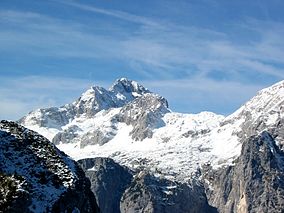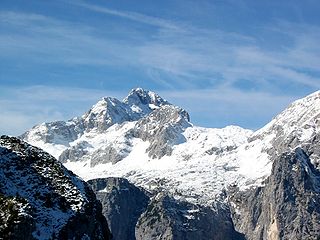
Triglav, with an elevation of 2,863.65 metres (9,395.2 ft), is the highest mountain in Slovenia and the highest peak of the Julian Alps. The mountain is the pre-eminent symbol of the Slovene nation. It is the centrepiece of Triglav National Park, Slovenia's only national park. Triglav was also the highest peak in Yugoslavia before Slovenia's independence in 1991.
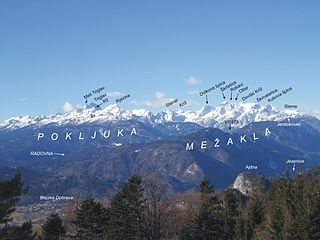
The Julian Alps are a mountain range of the Southern Limestone Alps that stretch from northeastern Italy to Slovenia, where they rise to 2,864 m at Mount Triglav, the highest peak in Slovenia. A large part of the Julian Alps is included in Triglav National Park. The second highest peak of the range, the 2,755 m high Jôf di Montasio, lies in Italy.

Slovenia offers tourists a wide variety of landscapes: Alpine in the northwest, Mediterranean in the southwest, Pannonian in the northeast, and Dinaric in the southeast. They roughly correspond to the traditional regions of Slovenia, based on the former four Habsburg crown lands. Each offers its own natural, geographic, architectural, and cultural features. Slovenia has mountains, meadows, lakes, caves, and the sea, making it an attractive destination in Europe.

In Slovene folklore, Goldhorn or Goldenhorn is a legendary white chamois buck, or alternatively, an Alpine ibex, that had his realm in the heights of Mount Triglav, the highest mountain in Slovenia and the highest peak of the Julian Alps. The legend is well known throughout Slovenia, as well as in Austrian Carinthia, and Italian Friuli Venezia Giulia.

Tolmin is a small town in northwestern Slovenia. It is the administrative centre of the Municipality of Tolmin.

The Triglav Lakes Valley is a rocky hanging valley in the Julian Alps in Slovenia, below the sheer sides of Mount Tičarica and Mount Zelnarica southwest of Triglav. The valley is also called the Seven Lakes Valley, although there are ten and not seven lakes in the valley. It is above the tree line and is geologically alpine karst; therefore it has also been termed the Sea of Stone Valley.

Bovec is a town in the Littoral region in northwestern Slovenia, close to the border with Italy. It is the central settlement of the Municipality of Bovec.
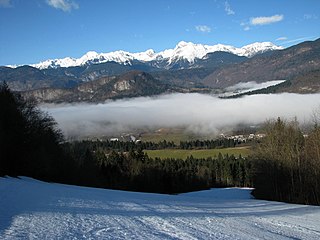
Bohinj, or the Bohinj Valley or Bohinj Basin, is a 20 km long and 5 km wide basin in the Julian Alps, in the Upper Carniola region of northwestern Slovenia. It is traversed by the Sava Bohinjka river. Its main feature is the periglacial Lake Bohinj. Bohinj is part of the Municipality of Bohinj, the seat of which is Bohinjska Bistrica.
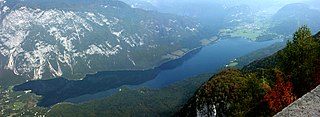
Lake Bohinj, covering 318 hectares, is the largest permanent lake in Slovenia. It is located within the Bohinj Valley of the Julian Alps, in the northwestern Upper Carniola region, and part of Triglav National Park.

The Sava Bohinjka is a headwater of the Sava River in northwestern Slovenia. At 41 kilometres (25 mi) in length, it is the shorter of the two headwaters that become the Sava River in the town of Radovljica, the other being the 45 km (28 mi)-long Sava Dolinka.

Bohinjska Bistrica is the largest settlement and administrative centre of the Municipality of Bohinj, in the Upper Carniola region of northwestern Slovenia.

The Tolmin Museum is public institution which covers the areas of archaeology, ethnology, general history and history of arts at upper Soča Valley region in Slovenia. It is located in the Coronini mansion in Tolmin.

Trenta is a settlement in the Municipality of Bovec in the traditional Gorizia region in western Slovenia.
Kneške Ravne is a dispersed settlement in the hills north of the Bača Valley in the Municipality of Tolmin in the Littoral region of Slovenia. It lies in the southern border area of Triglav National Park and is a popular starting point for hikes in the southwestern Julian Alps. The settlement has been part of the park since 2010.

The Gorizia Statistical Region is a statistical region in western Slovenia, along the border with Italy. It is named after the Italian town of Gorizia.
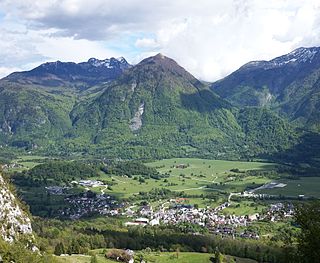
The Municipality of Bovec is a municipality in northwestern Slovenia. Its center is the town of Bovec. As of June 2016, its mayor is Valter Mlekuž.
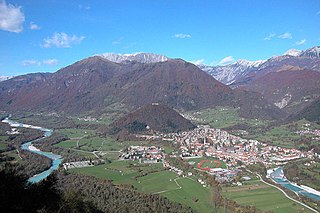
The Municipality of Tolmin is a municipality in northwestern Slovenia. Its seat and largest settlement is Tolmin.

The Municipality of Kranjska Gora is a municipality on the Sava Dolinka River in the Upper Carniola region of northwest Slovenia, close to the Austrian and Italian borders. The seat of the municipality is the town of Kranjska Gora.
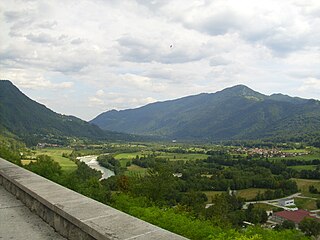
The Municipality of Kobarid is a municipality in the Upper Soča Valley in western Slovenia, near the Italian border. The seat of the municipality is the town of Kobarid.
